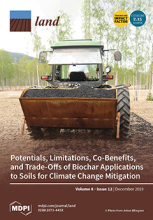/ library resources
Showing items 1 through 9 of 53.Spatially explicit assessments of ecosystem services (ES) potentials are a key component in supporting a sustainable land use management. The ES matrix method is a commonly used approach as it allows for a comparably fast, comprehensible and accessible ES assessment.
Although the way in which vegetation phenology mediates the feedback of vegetation to climate systems is now well understood, the magnitude of these changes is still unknown.
Although land forms the basis for marginal livelihoods in Sub-Saharan Africa, the asset is more strategic for women as they usually hold derived and dependent rights to land in customary tenure areas.
The understanding of relationships between ecosystem services and the appropriate spatial scales for their analysis and characterization represent opportunities for sustainable land management.
Traditional villages are important carriers of traditional cultural heritage, and they have strong historical, cultural, aesthetic and tourism value for all countries and the international community.
Conservation agriculture may lead to increased penetration resistance due to soil compaction. To loosen the topsoil and lower the compaction, one-time inversion tillage (OTIT) is a measure frequently used in conservation agriculture.
The rain gardens at Bryggen in Bergen, Western Norway, is designed to collect, retain, and infiltrate surface rainfall runoff water, recharge the groundwater, and replenish soil moisture.
Rural households are micro-organizational systems that are composed of different family members.
Documentation of land rights can ensure tenure security and facilitate smooth land transactions, but in most countries of the global south this has been difficult to achieve.
Pagination
Land Library Search
Through our robust search engine, you can search for any item of the over 73,000 highly curated resources in the Land Library.
If you would like to find an overview of what is possible, feel free to peruse the Search Guide.





